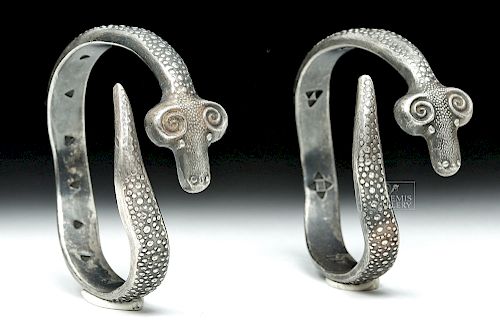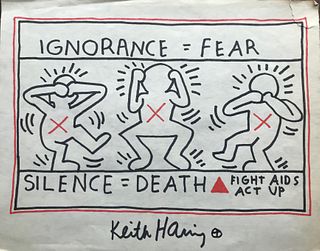Viking Silver Serpent Bracelet Pair - 144.3 g
Lot 88
About Seller
Artemis Fine Arts
686 S Taylor Ave, Ste 106
Louisville, CO 80027
United States
Selling antiquities, ancient and ethnographic art online since 1993, Artemis Gallery specializes in Classical Antiquities (Egyptian, Greek, Roman, Near Eastern), Asian, Pre-Columbian, African / Tribal / Oceanographic art. Our extensive inventory includes pottery, stone, metal, wood, glass and textil...Read more
Categories
Estimate:
$5,000 - $7,500
Absentee vs Live bid
Two ways to bid:
- Leave a max absentee bid and the platform will bid on your behalf up to your maximum bid during the live auction.
- Bid live during the auction and your bids will be submitted real-time to the auctioneer.
Bid Increments
| Price | Bid Increment |
|---|---|
| $0 | $25 |
| $300 | $50 |
| $1,000 | $100 |
| $2,000 | $250 |
| $5,000 | $500 |
| $10,000 | $1,000 |
| $20,000 | $2,500 |
| $50,000 | $5,000 |
| $100,000 | $10,000 |
| $200,000 | $20,000 |
About Auction
By Artemis Fine Arts
May 10, 2018
Set Reminder
2018-05-10 10:00:00
2018-05-10 10:00:00
America/New_York
Bidsquare
Bidsquare : Fine Ethnographic / Asian / Ancient Art
https://www.bidsquare.com/auctions/artemis-gallery/fine-ethnographic-asian-ancient-art-3213
Featuring antiquities from around the world including Pre-Columbian, Tribal, Classical, Asian, so much more! Artemis Fine Arts info@artemisfinearts.com
Featuring antiquities from around the world including Pre-Columbian, Tribal, Classical, Asian, so much more! Artemis Fine Arts info@artemisfinearts.com
- Lot Description
Northern Europe, Viking / Norse culture, ca. 9th to 10th century CE. A stunning pair of silver bracelets of serpentine form, each presenting a head at one end adorned by scrolled eyes and a protruding snout (two granules marking the upper end and two marking the lower end of the snout), and a sinuous body made to wrap around the wearer's wrist with meticulously rendered skin adorned by circular scale motifs. The interior faces of each bracelet are stamped with triangular motifs, some isolated and other paired or arranged in trios or quads. The serpent form relates to the Norse myth of Jormungandr (Jormungand), the Midgard Serpent, a child of Loki and a giantess who according to legend grew so large that it was able to surround the earth and grasp its own tail, forming an ouroboros. Size: larger bracelet measures 2.625" W (6.7 cm) in diameter (6.4 cm) with a 2.25" in diameter (5.7 cm) opening; the other bracelet is only slightly smaller; Weights: larger measures 75 grams and the other measures 69.3 grams; Total Weight: 144.3 grams
According to legend, when the Midgard Serpent releases its tail, Ragnarok - the final battle of the gods that will result in Earth becoming completely covered in water - will begin. One of the most popular motifs in Norse art concerns the story of Thor and Jormungandr. In classic Thor style, he sets off on a reckless fishing expedition, taking the head of an ox as his bait, and sails further out to sea than he should. With a large hook and the ox head, he catches Jormungandr, who surfaces, poison and blood dripping from his mouth. Thor's terrified fishing companion, the giant Hymir, quickly cuts Thor's line before he can slay the serpent with his hammer and Jormungandr sinks beneath the waves, the threat at bay - for the moment. Multiple Viking picture stones have been found depicting this story, including one from as early as the late 8th century.
A piece such as this would have been made in a specialized workshop centered around a hearth, most likely using the lost wax casting technique. The important Viking metalworking shops correspond to their great trading ports and proto-urban centers - Birka, Helgo, Sigtuna, and Lund in Sweden, Ribe, Haithabu (Hedeby), and Fyrkat in Denmark, and Kaupang and Trondheim in Norway. Silver was the principal currency of the Viking world, which stretched from Russia to northern Canada at the height of their influence. In many places, the Vikings kept silver not as coins, but as jewelry, a wearable currency form that was not subject to the authority of a monarch or mint. One of the most common archaeological finds from the Viking period is a hoard of metal objects, often buried in the earth or deposited in bodies of water, like river beds.
Provenance: private New York, New York, USA collection
All items legal to buy/sell under U.S. Statute covering cultural patrimony Code 2600, CHAPTER 14, and are guaranteed to be as described or your money back.
A Certificate of Authenticity will accompany all winning bids.
We ship worldwide and handle all shipping in-house for your convenience.
#132866There is some surface wear and tarnish commensurate with age; however, most details are still vivid. Both bracelets are beautiful and wearable.Condition
- Shipping Info
-
All shipping is handled in-house for your convenience. Your invoice from Artemis Gallery will include shipping calculation instructions. If in doubt, please inquire BEFORE bidding for estimated shipping costs for individual items.
-
- Buyer's Premium



 EUR
EUR CAD
CAD AUD
AUD GBP
GBP MXN
MXN HKD
HKD CNY
CNY MYR
MYR SEK
SEK SGD
SGD CHF
CHF THB
THB















